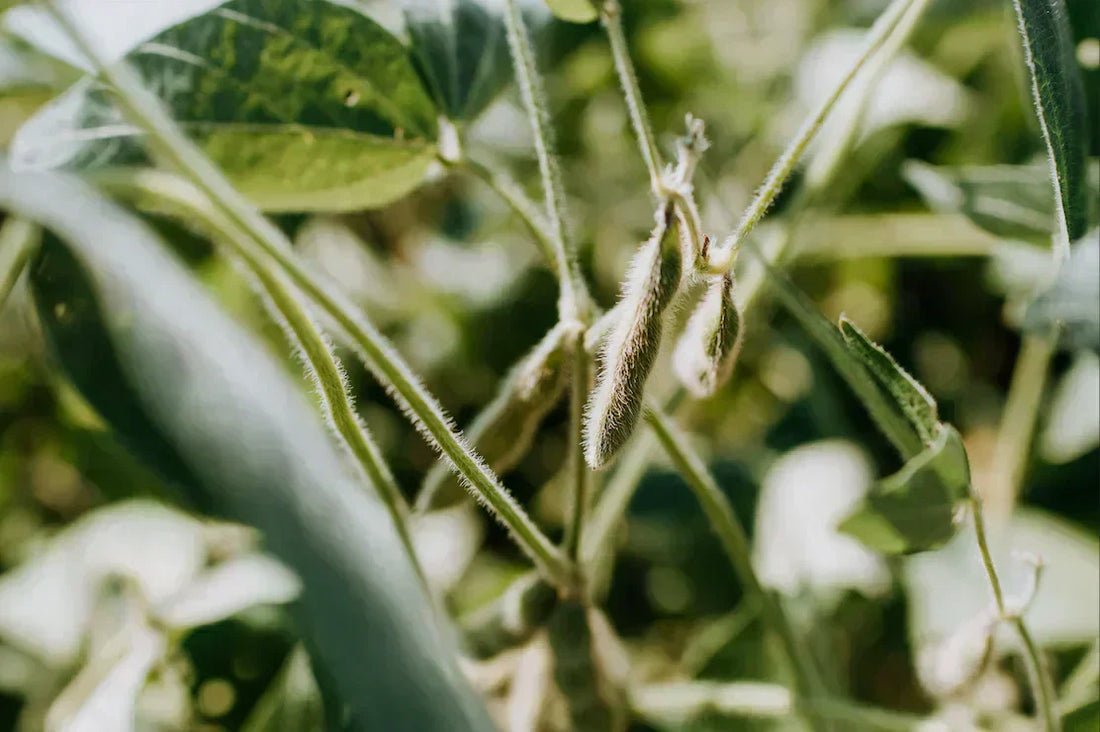
The Hidden Cost of Soybean Animal Feed: Why Insect Protein Is a Better Alternative
Share
This blog will explore the impact of the soy boom and its role in soy deforestation, a large explosion in demand for soybeans due to their use as cheap protein-dense soybean animal feed, but not a truly sustainable feed option. It will explore the soybean farming environmental impact on forests, water, and soil quality, and investigate the impact on human populations. Finally, we will explore the options being considered to reduce the harm being caused.
Called the "king of beans" by many, soybean is a crop grown for its high soy protein, vitamin and mineral content, versatility, and ability to grow in many climates. Soy is popular in Asian cuisine and as a meat replacement for vegetarians, though it’s mainly used for animal feed. Soy is grown worldwide, but 80% is grown in only three countries: Brazil, Argentina, and the United States. These countries fuel the meat industry – 75% of soybeans are crushed into powder to feed an ever-expanding population of animals, mostly chickens and pigs, enabling world meat production to triple in half a century. Soy production has doubled since 2000, in line with the demand for meat from growing economies like China and India. Brazil is projected to increase production by 30% to 180 million tons by 2030, which raises many environmental concerns due to the harmful effects of the current soy boom and its role in soy deforestation. So, what are the effects of the soy boom, and is it sustainable?

1. Deforestation and the change in land use
To accommodate the increasing demand, farms have enlarged all across the Americas. Between 2008 and 2016, U.S. farmland increased by an average of 400,000 hectares per year. In South America, soybean farms doubled in size from 2000–2019, totaling 55 million hectares – an area larger than France. Worryingly, rapid expansion is occurring in the Amazon Rainforest, where 4.6 million hectares, an area the size of Denmark, have been converted to farmland, contributing to deforestation for soy.
The conversion of the Amazon into farmland has been slow in the past due to the Amazon Soy Moratorium, an agreement between companies to stop buying deforestation-linked soy. Sadly, this success has been eroded by the Brazilian government, which has allowed the rainforest to be cut down for farmland and grazing pastures. Loggers use a “slash-and-burn” method, where a deforested area is burned to add fertile ash to the soil, but this has meant an uptick in wildfires during the driest season. This has been devastating for the Amazon, which historically was the world’s largest carbon sink of CO2 – it now emits more greenhouse gases than it absorbs. A tenth of all known species of plants and animals live in the Amazon; research has found at least 14,000 species have been affected in some way by wildfires, and 10,000 are at risk of extinction due to soy deforestation. Land expansion also has the potential to displace thousands of indigenous people from their formerly protected land.

Soy Deforestation Beyond the Amazon
Encroachment hasn’t just occurred in the Amazon. All of Brazil’s biomes have been affected. In Argentina, soy production has been the primary driver of the deforestation of 7.8 million hectares of their Gran Chaco forest, incentivized by low taxes. This has displaced indigenous populations, forcing them to abandon their livelihoods. Soy has also caused deforestation in the Bolivian and Paraguayan Chaco regions and is replacing natural grasslands in Uruguay and the central U.S. prairies.
Soy farms now make up 8.5 million hectares, or 6%, of the Atlantic Forest, a biome that has been deforested so much it now represents only 15% of its pre-colonization size. In the Pampas, where soy is replacing a long tradition of cattle ranching, correlations show that planting 100 hectares of soy reduces the cattle population by 76. Over 1.5 million hectares, or 10%, has been converted for soy.
The true victim of soy farming has been the Cerrado, a savanna that covers 20% of Brazil and is home to 10,000 species of plants. The soils are unfertile, so agriculture was limited until subsidies were introduced in the 1970s. Since 1985, it has lost 26.5 million hectares due to deforestation and is releasing emissions at a large rate. The Brazilian government estimated that emissions from converting the Cerrado were equivalent to half of the UK’s emissions in 2009.
2. Soy Feed and Water Pollution: Environmental Concerns
The Pantanal is the world’s largest tropical wetland. It has yet to be extensively converted to farmland; however, the effects of the soy boom have manifested in declining water quality due to upstream soy operations. Over 500 million liters of pesticide have been used on soy feed in Brazil – 60% of the nation’s total pesticide usage – averaging 17 liters per hectare. A study showed that at least 10 pesticides and herbicides were present in the waters and sediments of the Pantanal. Scientists project this number will increase by 4.3 million liters, causing a 46% rise in contamination levels downstream.
River sediments in soy-producing regions of Argentina, Brazil, and Paraguay revealed multiple insecticides in each sample, with some reaching toxic concentrations for fish. Brazilian streams even contain banned pesticides like Organochlorine. Research has linked high pesticide use in Mato Grosso to a rise in childhood cancers and birth defects. This highlights the severe soybean farming environmental impact on freshwater ecosystems.

3. Water consumption
With every crop extracting from the same soil layers and removing water-storing organic matter, monoculture soy farming also leads to large-scale water depletion. This increases overall soy water consumption, forcing farmers to use even more water with each harvest. Deforestation has also reduced annual rainfall in the Cerrado by 8.4% between 1977 and 2010 due to decreased transpiration.
Corporate soy farms can afford to keep irrigating during droughts, but smaller farmers and villages are often left dry. In one notable event – the Correntina water war – 1,000 villagers invaded a large farm and destroyed its water-pumping equipment to protest the depletion of local water supplies.
4. Soil Erosion from Soy Farming: A Growing Threat
Monoculture farming, where the same crop is grown repeatedly, causes nutrient depletion and soil erosion. With roots occupying the same soil depth, nutrients and water are drawn from the same layer each season. Fertilizers can temporarily replace lost nutrients, but over time the soil degrades.
A study in the 2000s found that soy farming in the Cerrado led to the erosion of 8 tons of soil per hectare annually. With lower biodiversity, crops become more susceptible to pests and weeds, prompting farmers to use even more pesticides and weed killers. The result is further pollution of soil, air, and water systems.
5. Social Impact of Soybean Farming and Land Displacement
Encouraged by former President Bolsonaro’s policies, Brazilian soy farms are now being built on occupied land. Over 239,000 hectares of indigenous territory have been approved for development. An exposé found that major soy feed traders like Cargill and Bunge had ties to farms responsible for violent evictions and even murder.
Meanwhile, the soy boom has pushed family-owned farms out of business. In Argentina, low taxes and high demand led corporations to buy up massive amounts of land. By 2008, just 2% of companies owned 50% of soy plantations. Between 1988 and 2008, the number of independent farms dropped by nearly half. Similar trends are unfolding across Latin America, displacing hundreds of thousands of farmers and indigenous communities.
Solutions to Soybean Farming Environmental Impact
Greenpeace, which helped establish the Amazon Soy Moratorium, is now pushing to include other biomes like the Cerrado and Gran Chaco. In one protest, activists blocked a soy freighter to pressure the EU to pass legislation that protects the Cerrado.
Governments are taking action too. In China – the world’s largest soy market – the Ministry of Agriculture is promoting soy alternatives and reducing reliance on imports. Pig and fish farmers are cutting soy content by using synthetic amino acids. The EU is working toward making all soy imports deforestation-free by 2025.
China and Europe are also boosting domestic soybean production. Europe produced nearly 10 million tons of soy in 2021, a 6% increase. China’s top soy-growing province expanded by 700,000 hectares with the help of subsidies. According to the 14th Five-Year Plan, China aims to boost production by 40% to reach 23 million tons by 2025.

Can soy be replaced?
Yes. Researchers and farmers are testing multiple soy alternatives, including alternative oilseeds, processed animal proteins, microalgae feed, and synthetic amino acids. But one of the most promising options is insect protein for animal feed.
Insects like black soldier fly larvae thrive on waste, converting it into high-quality insect protein for livestock. This model of sustainable animal feed creates a closed-loop system with minimal emissions and land use. In the UK, retailer Morrisons has begun using insect-based feed to produce carbon-neutral eggs.
Conclusion
Soybeans are a high-protein crop widely used to create cheap animal feed, especially in poultry and pork farming. But the environmental and social costs are too high. The soy boom has fueled deforestation, wildfires, droughts, chemical pollution, and land displacement. These effects, if unchecked, may permanently harm ecosystems like the Amazon and Cerrado.
The alternative? Replace soy with insect protein for animal feed, which turns waste into nutrition while minimizing land, water, and pesticide use. It's a sustainable, scalable path forward – and a vital part of the future of ethical, environmentally responsible farming.
